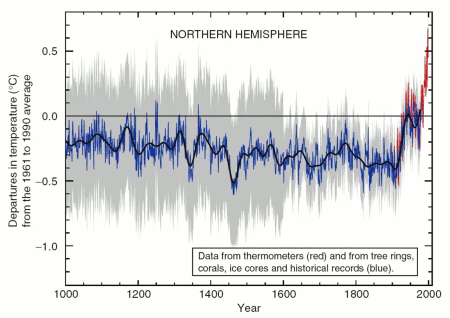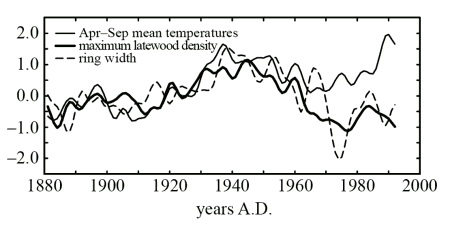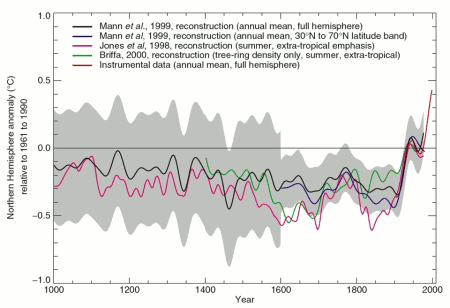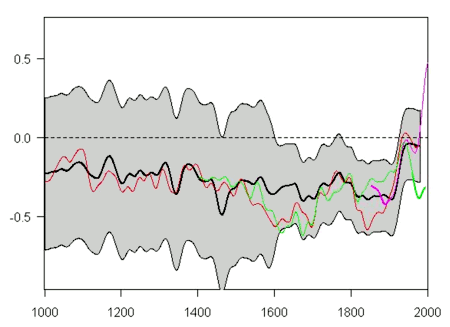One disputed issue remains fundamental to concerns over global warming. It is whether 20th century warming is so exceptional that it can only be explained by changes to the atmosphere caused by burning fossil fuels. It, and with it the theory of human causation, is incapable of absolute proof and is at best a matter of judgment, or if the arguments are not fully considered, simply a matter of belief.
How the IPCC has dealt with this issue exposes poor process, bias and concealment that make the IPCC assessments unreliable as the monopoly authority on the science.
The IPCC had been set up in 1988 with the Governing Principle stating its role as “to assess on a comprehensive, objective, open and transparent basis the scientific, technical and socio-economic information relevant to understanding the scientific basis of risk of human-induced climate change”. It was to review published papers, record differing scientific views and ensure that reviewers of its draft reports had access to any materials referenced in the papers it cited.
Advertisement
In its First Assessment Report (FAR) in 1991 the IPCC reported the alarming forecasts from the climate models that had led to its formation but said of 20th century warming, “A global warming of larger size has almost certainly occurred at least once since the end of the last glaciation without any appreciable increase in greenhouse gases. Because we do not understand the reasons for these past warming events, it is not yet possible to attribute a specific proportion of the recent, smaller warming to an increase of greenhouse gases.”
At the time the consensus view of scientists was that it had been much warmer in earlier interglacial periods as well as in the Medieval, Roman and Minoan times. The FAR showed this in three panels the third of which is reproduced below, showing the Medieval Warm period still warmer than now and the more recent Little Ice Age from which some argue we may still be recovering. If the 1991 view of historic temperature were true it places limits on the possible role of greenhouse gases.

Average global temperatures from 1000 AD as shown in the First IPCC Assessment
Despite the uncertainty of the FAR the United Nations Framework Convention on Climate Change was signed in 1992, which implicitly accepted human causation. This seemed to mark a turning point and no subsequent IPCC report details differing scientific views as to human causality.
The Second Assessment Report of 1995 noted growing confidence in climate models and hinted at research that might prove late 20th century warming to be unique in 10,000 years, reversing the earlier consensus view. Some, however, had managed to prevail upon the authors to include in the final draft differing expert views on the reliability of models but these were unceremoniously deleted from the published text. Few dissenting scientists now take part in the IPCC process.
Looked at from the point of view of “marketing” global warming to a sceptical audience the FAR view of historic temperatures was a major hurdle. In 1996 one IPCC lead author is reported to have said, “We must get rid of the Medieval Warm Period”. His wish was soon granted. In 1988 the first of the two “hockey stick” papers was published. Its lead author was a 32-year-old Michael Mann who received his PhD the same year.
Advertisement
In 1999 the study was extended to suggest that from 1000 AD average global temperatures fell gradually at about 0.02C per century until the middle of the 19th century. Dr Mann became a lead author of WGI Chapter 2 that featured his studies in the IPCC Third Assessment Report (TAR) of 2001.

Average N.H. temperatures from 1000 AD as shown in the Third IPCC Assessment
On first seeing the “hockey stick”, shown above, veteran climate researcher Gerald North said "The planet had been cooling slowly until 120 years ago, when, bam!, it jumps up," ... "We've been breaking our backs on [greenhouse] detection, but I found the 1000-year records more convincing than any of our detection studies."
As well as in Chapter 2 it appeared in the Summary for Policymakers and the “Synthesis Report” of the TAR. Environmentalists and the media relentlessly promoted it, as proof of human causation of global warming. However it had never been independently verified and was fatally flawed.
As we do not have thermometer readings for long ago, historic temperatures are estimated using “proxies” that have some feature that is considered a good indicator of temperature and can be dated. For example, the age of trees can be dated by counting rings on living trees and matching patterns on dead trees. In some places evidence is found of ancient tree lines at higher altitudes than trees presently grow, suggesting it was once warmer. The variation in tree ring width and density can in some circumstances follow local temperatures quite closely but in others less well and even inversely. In this and other areas climate scientists “cherry pick” data series, and techniques that tell the story they want.
At a recent CIRES meeting, Gerald North stated that “cherry picking” is a legitimate method in palaeoclimatology. He said because one is looking for a certain, elusive “signal” from the noise, that’s the only way to find the data.
This is an appropriate juncture to consider the “consensus of thousands of scientists” so often mentioned in the media. The chairman of the IPCC said the Fourth Assessment Report (AR4) was the work, rather than consensus, of 2500+ scientific expert reviewers, 800 contributing authors and 450 lead authors drawn from 130 countries.
The evidence from AR4 is that the expert reviewers have little effect on the controversial issues. WGI Chapter 2 of the TAR lists just ten authors. They also list 136 “contributing” authors but it is difficult to see how the crucial section on the “hockey stick” could have been written by anyone other than the young Dr Mann with the possible assistance of Dr Briffa and Dr Jones.

The “divergence” problem as shown by Briffa and Jones in 1998
In the same year as Dr Mann published his “hockey stick” two UK scientists Keith Briffa and Philip Jones with others published a paper entitled “Trees tell of past climates: but are they speaking less clearly today?” with a graph shown above. This paper shows a “divergence” problem after 1960 with many tree ring proxies but was not cited in the TAR although other work by Jones and Briffa was used as corroboration of the “hockey stick” in the graph shown below.

Studies by Mann, Jones and Briffa as shown in the IPCC Third Assessment Report
A fundamental duty of scientists, and advocates of any sort in a civilised society, is that they do not deliberately conceal matters that might weaken their case. If you look carefully at the graph above you can see that Briffa’s curve ends at 1960. However, in the paper it is taken from, it continues much further but falls away from the instrumental (thermometer) curve, which the authors wish to suggest their historic estimates are consistent with.
You should also note that instrumental curve used by Dr Mann was from a 1992 paper of Jones and Briffa. It is only plotted from 1902 both here and in his original papers, whereas the original Jones and Briffa paper shows data back to 1854. When the full data is plotted as shown below, copied from ClimateAudit.org, it is very clear that none of the reconstructions compare well with the known instrumental record and cannot therefore be reliable indicators of historic temperatures.

Missing data added to Figure 2.21 in IPCC, 2001 WGI Chapter 2
The “hockey stick” came under immediate attack, but for most it was impenetrable. The determination of Stephen McIntyre and Ross McKitrick finally unravelled it. The chronology of correspondence seeking to obtain full details includes more than one occasion of the removal from the Internet of previously available data. It demonstrated the lengths Dr Mann went to in order to avoid his study being scrutinised.
The papers published by McIntyre and McKitrick in 2003 and 2005 show that the hockey stick studies - among the most influential in history - were sloppy and plain wrong. Dr Mann was obliged to issue a corrigendum (PDF 44KB) in July 2004 acknowledging at least that his key IPCC study was documented in a careless way and was effectively unverifiable. Dr Mann was able to maintain a defence only because he refused to disclose all his data and code and argue that his critics were not correctly replicating his method.
Eventually the US House of Representatives became involved and two separate, independent expert groups were commissioned to provide peer reviewed reports on the matter. These reported (PDF 151MB) - under oath - to the House of Representatives six months before the IPCC began the release of AR4. They separately confirmed the work of McIntyre and McKitrick, which had shown that the “hockey stick” study contained three fatal flaws:
- it used inappropriate “strip bark” proxies that were responsible for the “hockey stick” shape;
- it used an incorrect statistical process that could find hockey stick shapes where none really existed; and
- it failed rigorous statistical validation.
The Wegman Report (PDF 1.41MB) demonstrated that the various historic reconstructions alleged to corroborate the “hockey stick” were not as independent as claimed, sharing both authors and data.
The second report was from the National Research Council (PDF 3.27MB) few of whom who could be described as climate sceptics. The views of its panel chairman Gerald North have already been mentioned, but he told the House of Representatives that he did not disagree with the methods or conclusions of Wegman and added, “In fact, pretty much the same thing is said in our report.” The NRC Report concluded, “Largescale temperature reconstructions should always be viewed as having a “murky” early period and a later period of relative clarity. The boundary between murkiness and clarity is not precise but is nominally around A.D. 1600.” Because of this they said it was only “plausible” that late 20th century warming is exceptional.
Wegman also said:
Based on the literature we have reviewed, there is no overarching consensus on MBH98/99. As analyzed in our social network, there is a tightly knit group of individuals who passionately believe in their thesis. However, our perception is that this group has a self-reinforcing feedback mechanism and, moreover, the work has been sufficiently politicized that they can hardly reassess their public positions without losing credibility.
But in the AR4 process under way it was close associates of Dr Mann and others equally committed to the “consensus” view that were charged with updating the assessment of historic global temperatures. The AR4 WGI Chapter 6 authors ignored the unequivocal invalidation of Dr Mann’s studies. Instead they extended and reinforced the earlier views based on other studies many of which were shown by Wegman not to be independent.
The IPCC tried to prevent the AR4 drafts and reviewers' comments from seeing the light of day but gave in to Freedom of Information Requests.
From them we can see that the review process was a sham and that the 16 lead authors of Chapter 6 were not willing to be deflected from their purpose. Two papers co-authored by a student of Dr Mann had been specifically commissioned - at the US tax payers’ expense - in an effort to undermine the work of McIntyre and McKitrick. One was rejected by the journal GRL but the other, which still referenced the first, was “provisionally accepted” by another journal but has never appeared in print.
Nevertheless it is relied upon in AR4 to suggest wrongly that the McIntyre and McKitrick papers do not invalidate the hockey stick. In my Energy and Environment paper (PDF 855KB), I review some of the AR4 drafting and review comments in detail but here I will conclude with the comment from the reviewer for the Government of the United States of America and the chapter authors’ reply:
Reviewers Comment 6-750: The use of Wahl and Ammann (accepted) does not comply with WG1’s deadlines and all text based on this reference should be deleted. WG1’s rules require that all references be “published or in print” by December 16, 2005. Wahl and Ammann was “provisionally accepted” on that date, and not fully accepted until February 28, 2006, at which time no final preprint was available. Substantial changes were made in the paper between December 16, 2005 and February 28, 2006, including insertion of tables showing that the MBH98 [“hockey stick”] reconstruction failed verification with r-squared statistics, as had been reported by McIntyre and McKitrick in 2003. These tables were not available in the draft considered by WG1 when developing the second-order draft.
[Govt. of United States of America (Reviewer’s comment ID #: 2023-415)]
Response: Rejected - the citation is allowed under current rules.